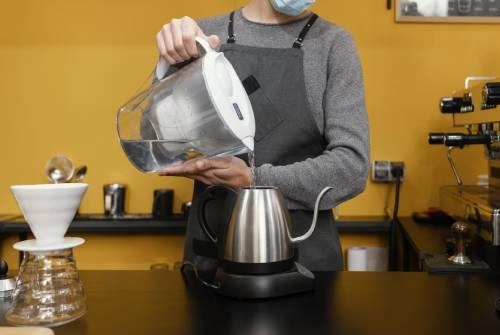How to Clean a Coffee Maker: A Comprehensive Guide for a Fresh Brew
Cleaning your coffee maker is an often-overlooked aspect of maintaining your kitchen appliances, yet it is crucial for ensuring your coffee tastes fresh and remains free of buildup. If you’ve been wondering how to clean a coffee maker effectively, you’ve come to the right place. In this detailed guide, we’ll walk you through the process of cleaning your coffee machine, highlighting why it’s essential to keep it spotless for better-tasting coffee and a longer-lasting appliance.

Why Is It Important to Clean Your Coffee Maker?
Many people assume that a simple rinse of the coffee pot after each use is enough. However, your coffee maker requires more attention to ensure it’s operating at peak performance. Over time, coffee makers accumulate coffee oils, mineral deposits from water, and even mold or bacteria. These residues can impact the taste of your coffee and potentially shorten the life of your machine.
Here’s why it’s important to clean your coffee maker regularly:
- Prevent Mineral Buildup: Water contains minerals such as calcium and magnesium that can accumulate inside the coffee maker, especially if you live in an area with hard water. Over time, this buildup can cause clogs and affect the performance of the machine.
- Enhance Coffee Flavor: Old coffee oils and grounds left behind after brewing can give your coffee a stale or bitter taste. By regularly cleaning your coffee maker, you ensure your brews are always fresh and delicious.
- Avoid Mold and Bacteria: Damp areas inside your coffee maker, like the water reservoir, can become a breeding ground for mold and bacteria. Regular cleaning helps eliminate this risk.
- Increase Machine Longevity: Just like any appliance, regular maintenance is key to making your coffee maker last longer. By ensuring that it’s clean and free of debris, you’ll help it function properly for many years.
How to Clean a Coffee Maker: A Step-by-Step Guide
Cleaning your coffee maker doesn’t have to be complicated. With the right approach, you can maintain your machine and ensure every cup of coffee is brewed to perfection. Follow these steps to learn how to clean a coffee maker thoroughly.
Step 1: Disassemble and Clean the Removable Parts
The first step in learning how to clean a coffee maker is to tackle the removable parts. These parts, including the coffee pot (or carafe), filter basket, and lid, are where most coffee oils and residues accumulate.
- Wash the Coffee Pot: After each use, always rinse the coffee pot with warm water and dish soap. For deeper cleaning, you can soak the pot in a mixture of baking soda and warm water to remove stubborn stains or coffee buildup.
- Clean the Filter Basket: If your coffee maker uses a reusable filter, be sure to rinse it thoroughly after each use to remove any remaining coffee grounds. For a more thorough clean, wash the filter with soap and warm water to remove any lingering oils.
- Wipe Down the Lid and Carafe: These parts are also prone to collecting coffee drips and oils. Wipe them down with a damp cloth and mild soap.
Step 2: Descale the Coffee Maker
Descaling your coffee maker is a vital step in the cleaning process, especially if you live in an area with hard water. Mineral deposits, also known as limescale, can accumulate inside the machine and affect its performance. Here’s how to descale your coffee maker and remove these deposits:
- Prepare a Cleaning Solution: To descale your coffee maker, you can use white vinegar or a store-bought descaling solution. The vinegar is a natural, affordable option and works effectively to break down mineral buildup.
- Mix the Solution: Fill the water reservoir with a 50/50 solution of white vinegar and water. If your machine is larger, use more vinegar and water accordingly.
- Run the Brew Cycle: Start the brew cycle, allowing the vinegar-water mixture to pass through the coffee maker. If your coffee maker has a “pause” feature, you can pause the cycle halfway through and let the solution sit for about 15 minutes. This will help to break down mineral buildup more effectively.
- Let it Sit: After the brewing cycle is complete, let the vinegar solution sit in the machine for 20 minutes. This gives the solution extra time to dissolve any limescale inside the coffee maker.
- Rinse Thoroughly: After the 20 minutes, discard the vinegar solution and rinse the carafe and water reservoir. Then, fill the reservoir with clean water and run several brew cycles to flush out any remaining vinegar and mineral deposits. You may need to repeat this step two or three times until the vinegar smell is completely gone.
Step 3: Clean the Water Reservoir and Heating Plate
Your coffee maker’s water reservoir and heating plate are two areas that can gather grime, stains, and mineral deposits over time. To clean these parts:
- Clean the Water Reservoir: Use a damp cloth with a small amount of dish soap to wipe down the inside of the water reservoir. If necessary, you can also use a mixture of vinegar and water to disinfect the reservoir and eliminate any leftover residues.
- Clean the Heating Plate: The heating plate can get coffee stains and spills over time. Use a damp sponge or cloth with a small amount of dish soap to gently clean the plate. Be careful not to use abrasive scrubbers that could scratch the surface.
Step 4: Dry and Reassemble the Coffee Maker
After all the parts have been cleaned, make sure to dry them thoroughly before reassembling the coffee maker. Any leftover moisture could encourage mold or mildew growth, which you want to avoid.
- Dry the carafe, filter basket, and other removable parts with a clean towel.
- Wipe down the exterior of the coffee maker with a dry cloth.
Step 5: Maintain Regular Cleaning Habits
Now that you know how to clean a coffee maker, it’s important to maintain regular cleaning habits to keep your machine in top shape.
- Daily Cleaning: After each use, clean the carafe, filter basket, and other removable parts. This ensures that coffee grounds and oils don’t build up and affect future brews.
- Monthly Deep Cleaning: Descale your coffee maker every month to prevent mineral buildup. If you have hard water, you may need to do this more frequently.
- Occasional Mold Prevention: If you notice any moisture inside the machine, wipe it down promptly to prevent mold from growing in hidden spots.
Conclusion
Knowing how to clean a coffee maker is essential for maintaining the taste, hygiene, and functionality of your machine. By following these simple steps—regularly washing the removable parts, descaling the internal components, and wiping down surfaces—you can ensure that your coffee maker stays in great condition. A clean coffee maker not only improves the flavor of your coffee but also helps extend the life of your machine.
By keeping up with routine maintenance, your coffee maker will continue to brew your favorite cups of coffee with ease and efficiency. Remember, a well-maintained coffee maker leads to a consistently fresh brew, so take the time to clean it and enjoy your coffee to the fullest.
Find more interesting Posts like this from here
Related
Discover more from how 2 blogs
Subscribe to get the latest posts sent to your email.
